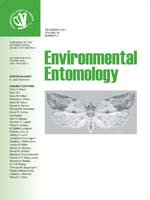Widespread destruction of tallgrass prairies in the midwestern United States has fragmented plant communities with the result that populations of endemic animal species have become geographically isolated from one another. The goal of the research summarized here was to evaluate the potential for conserving endemic prairie species of herbivorous insects by managing their host plants. Our study species was the weevil Haplorhynchites aeneus (Boehman), adults of which feed on pollen of plants in the genus Silphium (Asteraceae: Heliantheae). The female weevils clip the peduncles of flower heads and oviposit into the heads, where the larvae feed on the ovules. The research was conducted in 12 prairie sites in eastern Illinois. An allozyme analysis revealed that most populations of H. aeneus at the various prairie sites were genetically differentiated from one another, but the degree of differentiation was not associated with geographic distance between sites. Adult H. aeneus fed and oviposited on the plant species Silphium laciniatum L., S. integrifolium Michx., and S. terebinthinaceum Jacq, which differ in bloom phenology. There was no evidence of genetic differentiation of weevil populations with respect to host plant species, and adult weevils strongly preferred S. terebinthinaceum. We conclude that the oligophagous nature of the weevil assures its survival in small prairie remnants even where some of the host plant species are absent. Although H. aeneus can have a significant impact on reproduction of host plants by clipping flower heads, the perennial nature of Silphium species prevents their local extinction.
How to translate text using browser tools
1 December 2011
Consequences of Habitat Fragmentation for the Prairie-Endemic Weevil Haplorhynchites aeneus
Emily C. Kluger,
Stewart H. Berlocher,
John F. Tooker,
Lawrence M. Hanks
ACCESS THE FULL ARTICLE
It is not available for individual sale.
This article is only available to subscribers.
It is not available for individual sale.
It is not available for individual sale.

Environmental Entomology
Vol. 40 • No. 6
December 2011
Vol. 40 • No. 6
December 2011
Curculionidae
insect conservation
phytophagy
plant-insect interaction




